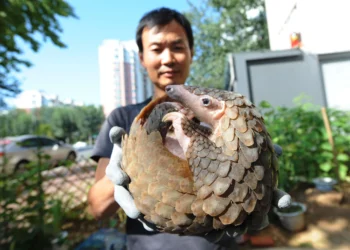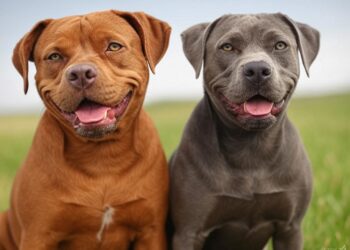The green-winged macaw (Latin: Ara chloropterus) is the largest macaw in the world and therefore also the largest parrot species. This brightly colored bird lives in rainforests and mountainous areas.
Unfortunately, the number of green-wing macaws has decreased in number over the years, because people destroy the natural environment of the parrot or change the living environment through forest clearing, for example. The parrot is also illegally hunted for the bird trade.
The green-wing macaw occurs naturally in the eastern part of Panama and in Parana, northwestern Colombia, Venezuela, and Guyana, as well as northern Argentina, northeast Bolivia, Paraguay, and Mato Grosso in Brazil, Suriname, and Peru.
This large parrot is sometimes seen in mountainous habitats at a height of 1.5 kilometers. Because the bird is kept as a pet and generates a lot of money in the trade of exotic animals, bird traders have it (illegally) hunted. Because the natural habitat of parrots is also being destroyed, the green-wing macaw has decreased in number.
Characteristics
Size
The green-winged macaw is the largest parrot of its kind. The length of the body is ninety centimeters and this bird weighs an average of one kilogram, which is relatively heavy for a bird. The pupa is smaller and lighter than the male macaw.
cup
The head of the parrot is round and has a hard strong bill at the front. It is sometimes said that the beak is an extra leg for the parrot because the bird does so much with the beak. With the head, the bird moves a lot from left to right, but also from top to bottom.
The head of the doll is somewhat rounder than the head of the male, also the beak of the doll is smaller and narrower than the beak of the male.
Beak
When this macaw opens the beak, a small tongue becomes visible. The round tongue is black in color. The bill of macaws is generally very strong and suitable for breaking hard nuts and other hard foods. The green-wing macaw’s beak is even strong enough to snap small branches off trees.
Eyes
Parrots have their (usually yellow or gray) eyes on two sides of their heads. Because of this, a parrot is used to making eye contact with only one eye at a time. The so-called reins (white masks) around the eyes consist of light skin, locally covered with small stubble feathers, creating a speckle-like effect.
hull
A bird’s shoulders are slightly twisted high on the torso. The macaw has a lot of freedom of movement in its shoulders and neck, and the head is therefore easy and spacious to move. The wings are primarily used for flying, but sometimes these large birds deal blows with the wings in combat.
Reading Suggestions; 300 Australian Parrot Names
plumage
The green-winged macaw has red, green and blue feathers. The head and back are predominantly red, the green feathers run in an even path over the wings and back. Blue and turquoise feathers are on the underside of the wings and in the tail. Red feathers are also found in the tail.
Legs
The legs contain rather sharp claws. The foot consists of three toes, two in front and one behind. Thanks to the sturdy legs with powerful claws, they can climb trees well.
Movements
The movements of the green-winged macaw are in fact typical of any other parrot species: in addition to flying, they can sit quietly, hop back and forth on a branch, move their head up and down, and they can walk. When walking, the legs are moved gently, almost gracefully, over (for example) branches of trees.
voice sound
Parrots have a scratchy and sharp voice. They naturally make a lot of noise by yelling, whistling, and imitating (each other). But they also use a variety of sounds to communicate with their peers.
When they are in danger or when they are in pain, parrots use a verbal diatribe. Parrots also claim their territory by shouting loudly.
Contact Scream
When they have lost their partner, they give a so-called ‘contact scream’ that can be recognized by the partner from a distance. They then repeat this scream to each other regularly, as long as the partner is out of sight, to make sure that the partner is still nearby.
If they lose the partner, through death or otherwise, the widow/widower is left alone for the rest of life.
Reproduction
Macaws are monogamous and choose a mate for life. When a couple builds a nest, about three eggs are laid within three to four days. The pupa incubates for four weeks. The male macaw does not incubate, but does pay attention to the pupa.
When all the eggs hatch, a chick usually dies within a short time. Biologists suspect that the female lays three eggs as eggs can easily break during the incubation period, causing the embryo to be lost.
Boy
Macaws are slow growers. They have a significant need for food, and the parents are busy raising the young. After three months, the boys will fledge. Macaws are sexually mature when they are about six or seven years old.
Reading Suggestions; 900+ Best Bird Names for Budgies, Parrots, Cockatoos, and More
Imitation
A parrot is good at mimicking environmental sounds. Sounds that the parrot often hears are often imitated after a while.
Learn to speak
Parrots can learn to speak. This ‘speaking’ consists of imitating words, intonation, and vocal sounds are often imitated surprisingly well. However, the parrot cannot have real conversations with people.
However, the (green-winged) macaw is not very good at mimicking human language. They can learn to repeat some words, but much less than the common small parrot species.
stress
If a parrot is under a lot of stress in captivity, the parrot may start to behave differently. He can bite himself, pluck himself, react with fear, and sometimes ‘paralyze.’ Lonely or stressed parrots bite faster, both humans and animals are at risk of being bitten by parrots anyway.
Food
These macaws eat nuts, seeds, fruit (also berries) and certain plants. They mainly look for food in nature in the tops of trees.
Age
Green-wing macaws can live to be seventy years or older. This means that if you take such a bird as a pet, there is a good chance that the macaw will outlive you.
Unsuitable as a pet?
The macaw attaches itself to only one person in the family, and it quickly sees the rest of the family as an intruder. As a result, the bird can react hostilely to anyone who is not that one person. This bird also requires a lot of care, attention, and variety in food given its size.
In view of the fact that he/she attaches itself to only one person, and partly because the bird is very old, the animal is not suitable as a pet according to many. Another problem is that this bird produces a lot of noise, making a charge for noise pollution in urban areas where houses are close together is certainly not inconceivable.
A macaw also makes a lot of noise, sometimes for hours on end. This bird requires a lot of attention and intensive care by all family members.









